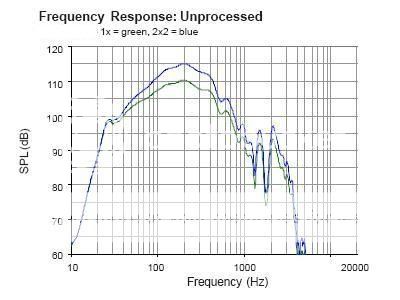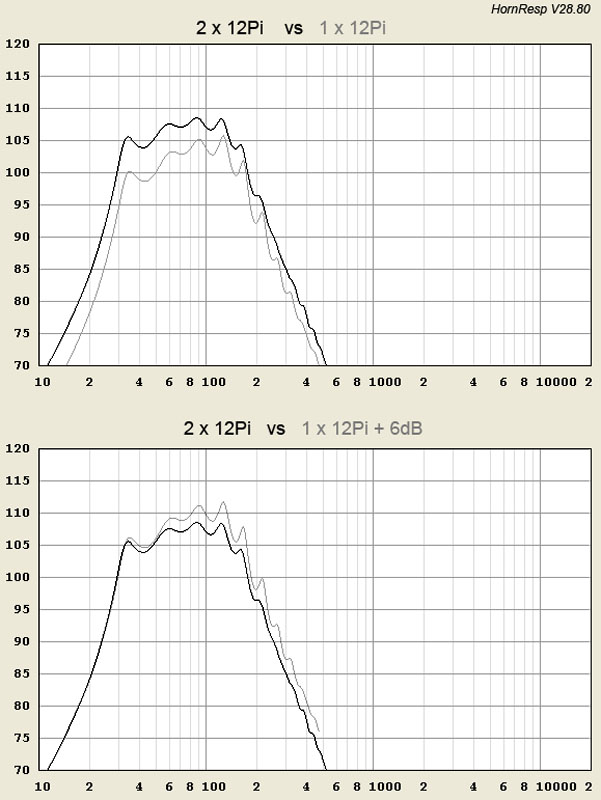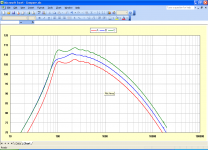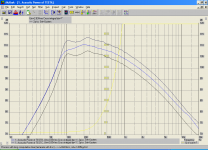I found a good source with sound power level and sound pressure level calculators (engineeringtoolbox.com):
Hi Oliver,
This also appears to be an excellent reference:
Loudspeaker Impedance, Series & Parallel Connection Basics — Reviews and News from Audioholics
Kind regards,
David
Hi David,
Looks to me that the radiator size dependent change in radiation resistance V. frequency was not taken properly into account in this article. Also, the table on P.2 seems to indicate that no matter how many times we double the number of radiators in the series connection the output SPL will not change, but the consumed power will divide by 2 for every doubling (if the author's assumptions would hold true for going from 1 speaker to 2 speakers, it should hold true going from 2 to 4, and so on....as long as the speakers are "co-located"); that just doesn't seem likely.
Regards,
Looks to me that the radiator size dependent change in radiation resistance V. frequency was not taken properly into account in this article. Also, the table on P.2 seems to indicate that no matter how many times we double the number of radiators in the series connection the output SPL will not change, but the consumed power will divide by 2 for every doubling (if the author's assumptions would hold true for going from 1 speaker to 2 speakers, it should hold true going from 2 to 4, and so on....as long as the speakers are "co-located"); that just doesn't seem likely.
Regards,
Good!Hi Art,
It seems that it will not be necessary to make any special adjustment for multiple tapped horns - the proposed new multiple speakers response calculation method appears to correct the problem automatically.
Kind regards,
David
It will still likely be years before people don’t expect an increase in LF relative to upper response for multiple TH, but glad that that misconception may be dissuaded once the code change is implemented.
After no response to my questions from Wayne, still wondering how his measured increase of 1.5 dB at 30 Hz for a pair of his FLH compares to the “old” and “new” code ?
Art
After no response to my questions from Wayne, still wondering how his measured increase of 1.5 dB at 30 Hz for a pair of his FLH compares to the “old” and “new” code ?
Not sure what you're asking for, Art. I posted measurements and Hornresp models, at least in the form that they are links in post 1288. I even wrote where to find what in each link, e.g. "Hornresp models in the following link", "measurements in the following link", and so on.
I always attributed the extra "boost" at low frequencies to the increased mouth size when going from one unit to two. The horn is physically large, but it isn't acoustically large. I would expect this behavior until the group was acoustically large, at around four units for the 12Pi. Same thing happens for LABhorns up to six units. Beyond that, I would expect SPL increases, but not "bass boost" from grouping. Once the FLH group is made acoustically large, it is most efficient all the way through the passband.
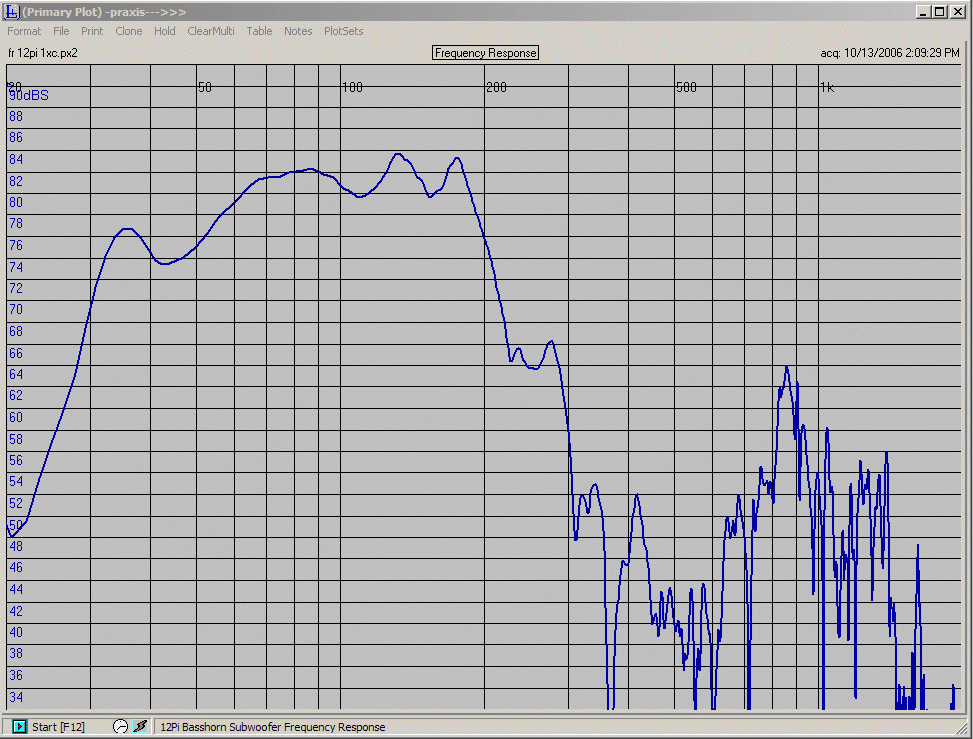
Single 12Pi v1 Basshorn
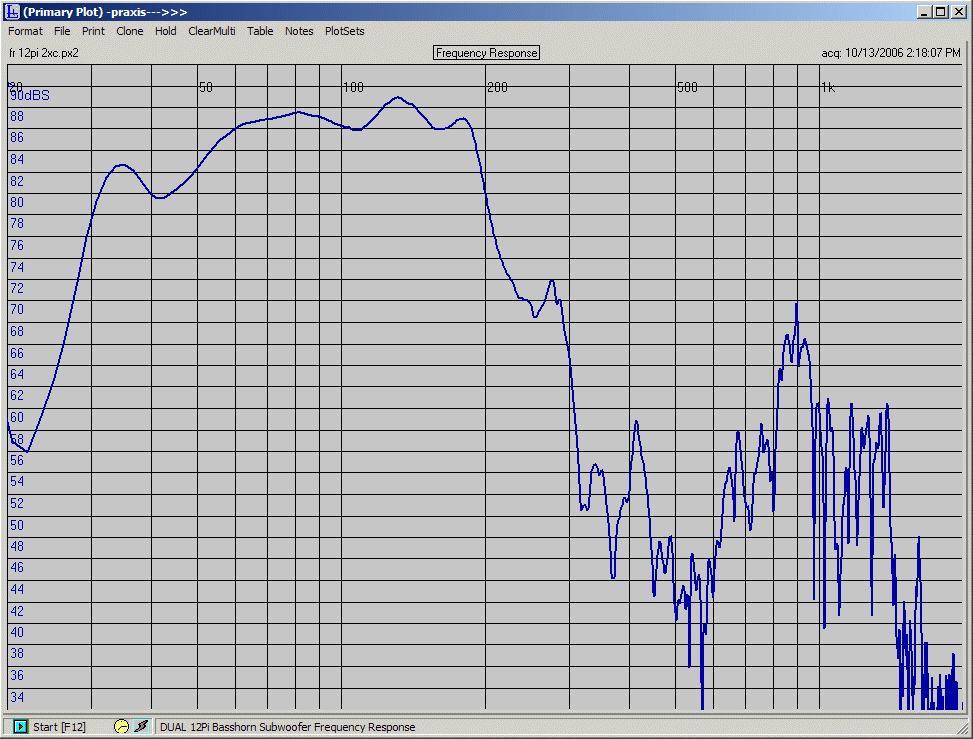
Pair of 12Pi v1 Basshorns
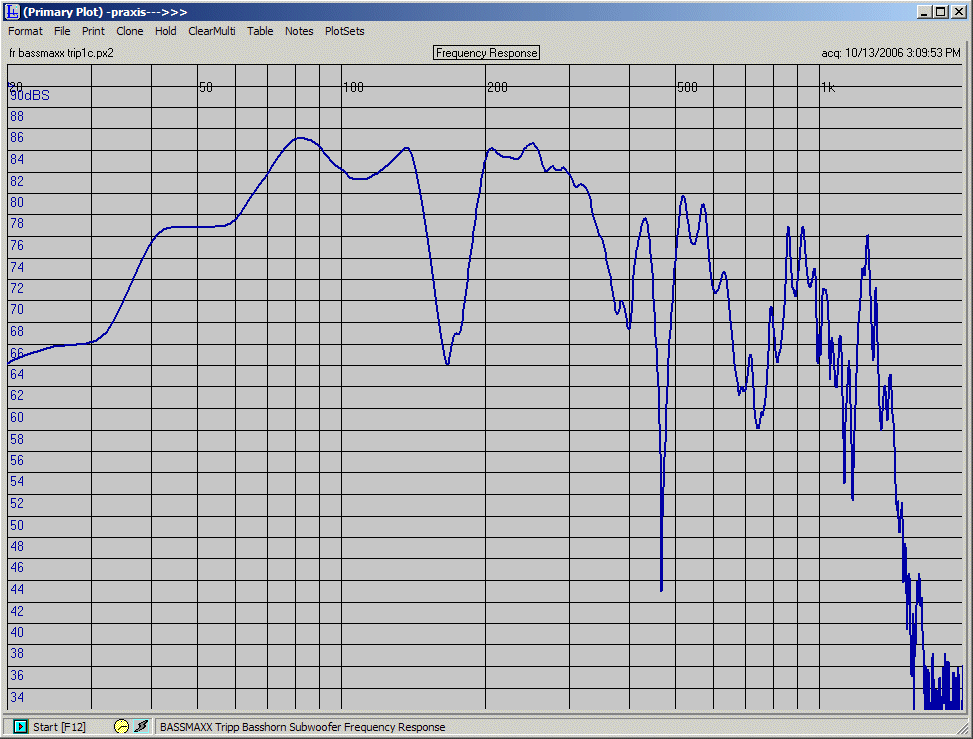
Single Bassmaxx Tripp Basshorn
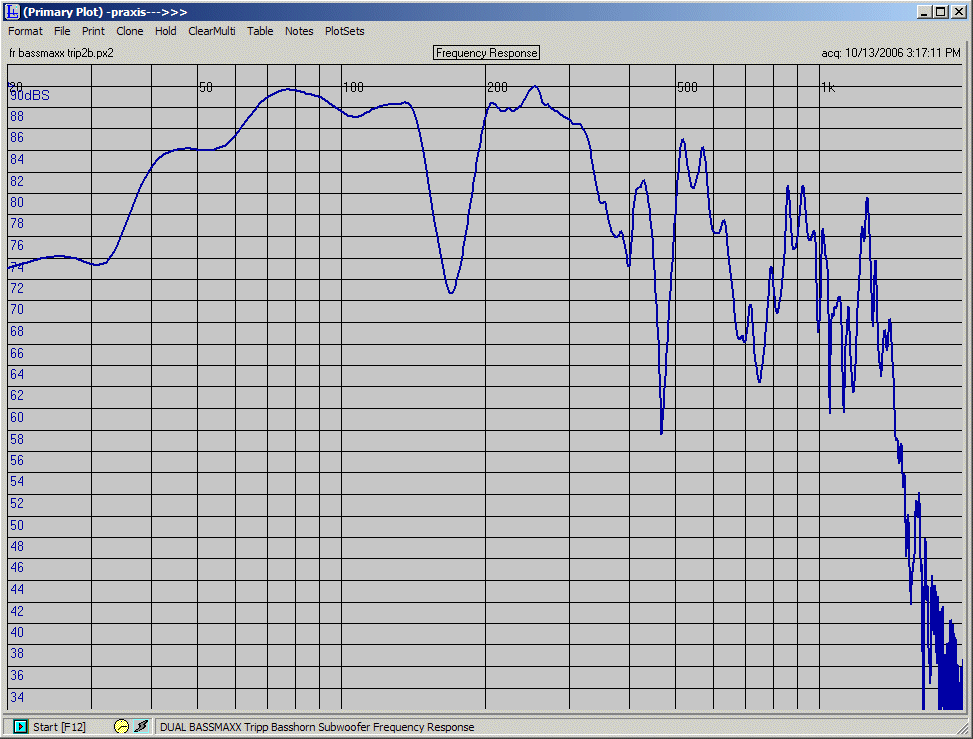
Pair of Bassmaxx Tripp Basshorns
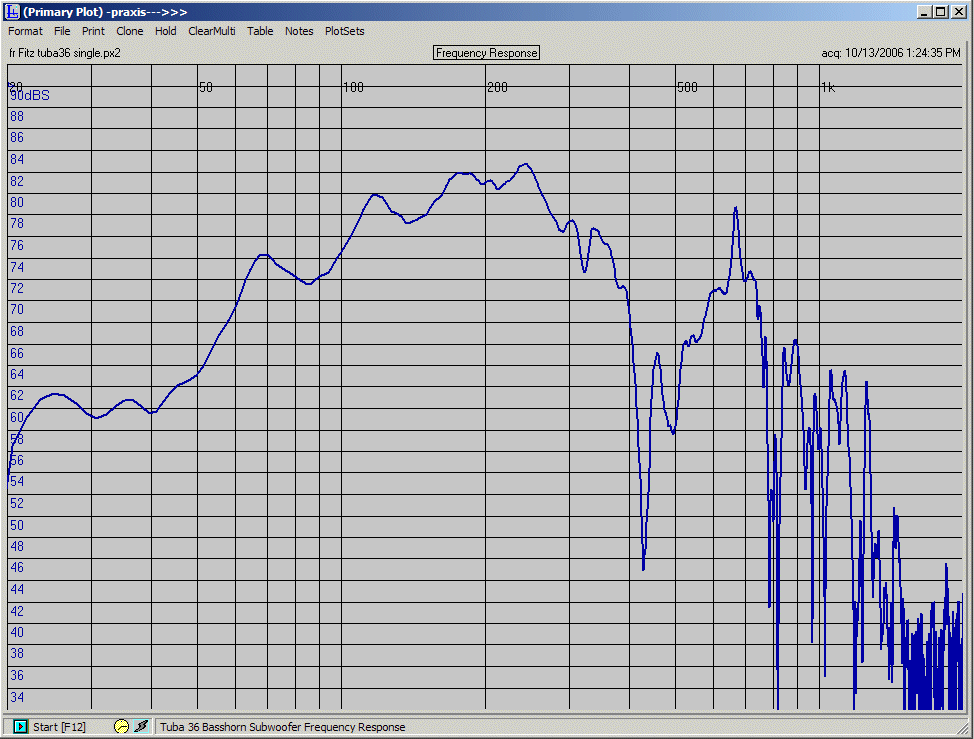
Single Tuba 36 Basshorn
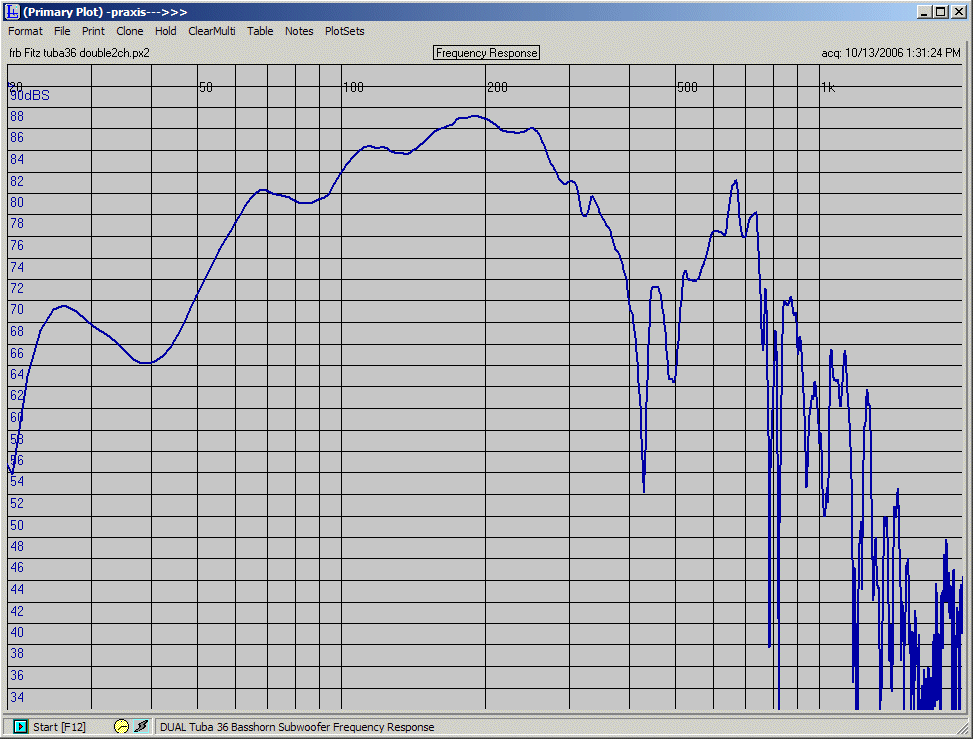
Pair of Tuba 36 Basshorns
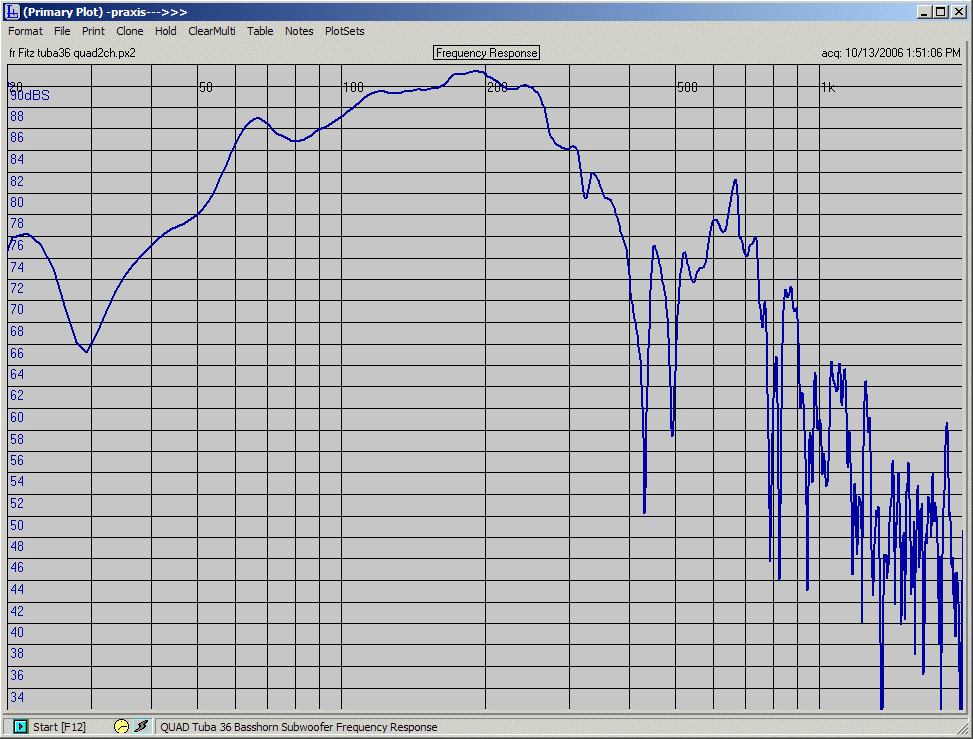
Group of four Tuba 36 Basshorns
Last edited:
Hi Art,
It seems that it will not be necessary to make any special adjustment for multiple tapped horns - the proposed new multiple speakers response calculation method appears to correct the problem automatically.
Kind regards,
David
Glad to hear this. Finally a solution that make sense, can't wait.
Thanks, Djim, for bringing the measurements and the models together, side-by-side. Easier to compare than pouring through all the threads linked from post 1288. Looks like there's pretty good agreement between the Hornresp model and the measurements. Beyond the 6dB increase, there's a smidge more from 45Hz to 65Hz and a smidge less from 65Hz to 100Hz. Maybe 1dB more down low and 1dB less up high, a total of ~2dB difference. That's pretty much what the Hornresp model shows, about 2dB less slope in the overall trend.
Your welcome Wayne, the differences are very small and in my view based on real life differences such as losses (driver) not represented by the model. However one thing I like to add, the model I used is based on your measurements to get an as close as possible model for 1 cab to see the difference between 1 and 2 cab measurement/modelling.
If this can help, I have found differents comparisons of multiple subwoofers measurement.
here, 1, 2 and 4 HD15 (BPH), 1 watt total power:
found here: Got a lot of plots eh wot... - Speakerplans.com Forums
Here, 2 and 4 punishers (FLH) 1 watt total power:
Found here: Got a lot of plots eh wot... - Speakerplans.com Forums
Here, 1, 2, 3, and 4 punishers, same voltage level:
I think the notches are just problem measurement
found here : Punisher plots - Speakerplans.com Forums - Page 1
Here, 1, 2, and 4 TH115 measurement:
Found here: PSW Sound Reinforcement Forums: LAB Subwoofer => danley sound labs TH-115 vs bassmaxx Z-5
Hope this help
here, 1, 2 and 4 HD15 (BPH), 1 watt total power:
An externally hosted image should be here but it was not working when we last tested it.
found here: Got a lot of plots eh wot... - Speakerplans.com Forums
Here, 2 and 4 punishers (FLH) 1 watt total power:
An externally hosted image should be here but it was not working when we last tested it.
Found here: Got a lot of plots eh wot... - Speakerplans.com Forums
Here, 1, 2, 3, and 4 punishers, same voltage level:
An externally hosted image should be here but it was not working when we last tested it.
I think the notches are just problem measurement
found here : Punisher plots - Speakerplans.com Forums - Page 1
Here, 1, 2, and 4 TH115 measurement:
An externally hosted image should be here but it was not working when we last tested it.
Found here: PSW Sound Reinforcement Forums: LAB Subwoofer => danley sound labs TH-115 vs bassmaxx Z-5
Hope this help
Hi Oliver,
The article does mention that mutual coupling between radiators is ignored.
It seems strange, I know, but that is exactly what the proposed new Multiple Speakers tool is going to predict.
In simple terms, given that Power = (Eg ^ 2) / R, for constant Eg, as the load R is increased by placing more speakers in series, the total power delivered to the system is reduced.
The 6dB gained each time the number of speakers is doubled, is exactly offset by the 6dB lost due to the total input power being halved - putting things back to where they started.
In the limiting case, zero power is required to drive an infinite number of speakers - assuming no losses .
.
Kind regards,
David
Looks to me that the radiator size dependent change in radiation resistance V. frequency was not taken properly into account in this article.
The article does mention that mutual coupling between radiators is ignored.
Also, the table on P.2 seems to indicate that no matter how many times we double the number of radiators in the series connection the output SPL will not change, but the consumed power will divide by 2 for every doubling (if the author's assumptions would hold true for going from 1 speaker to 2 speakers, it should hold true going from 2 to 4, and so on....as long as the speakers are "co-located"); that just doesn't seem likely.
It seems strange, I know, but that is exactly what the proposed new Multiple Speakers tool is going to predict.
In simple terms, given that Power = (Eg ^ 2) / R, for constant Eg, as the load R is increased by placing more speakers in series, the total power delivered to the system is reduced.
The 6dB gained each time the number of speakers is doubled, is exactly offset by the 6dB lost due to the total input power being halved - putting things back to where they started.
In the limiting case, zero power is required to drive an infinite number of speakers - assuming no losses
Kind regards,
David
Multiple Speakers
Hi Everyone,
The first screenprint shows Hornresp results generated using the proposed new Multiple Speakers tool. The data has been exported to Excel for comparison purposes.
The second screenprint shows the equivalent AkAbak results. The two sets of results are essentially identical. There are slight differences above 10000 hertz, but these are of little practical significance.
Hornresp results:
The red trace shows the reponse for a single conical horn with a single driver, radiating into 2 Pi space.
The blue trace shows the response for a single conical horn, similar to the one used to generate the red trace, but with two drivers connected in parallel and the cross-sectional areas doubled, also radiating into 2 Pi space.
The green trace shows the response for two conical horns, each similar to the one used to generate the red trace, but connected in parallel and also radiating into 2 Pi space.
It would seem that the green trace results are similar to the measured results obtained by Art and Wayne.
The really interesting thing though, is that the level of the green trace is approximately +3 dB compared to the blue trace at higher frequencies, when it would seem that the two systems are effectively acoustically identical - the blue trace being generated using two drivers in a single horn having a mouth area of 2A, with the green trace being generated using two horns, each having a single driver and a mouth area of A.
I have not yet released an update to Hornresp, but will do so just as soon as the new multiple speakers model is fully validated and reason for the apparent anomaly described above is better understood.
Kind regards,
David
Hi Everyone,
The first screenprint shows Hornresp results generated using the proposed new Multiple Speakers tool. The data has been exported to Excel for comparison purposes.
The second screenprint shows the equivalent AkAbak results. The two sets of results are essentially identical. There are slight differences above 10000 hertz, but these are of little practical significance.
Hornresp results:
The red trace shows the reponse for a single conical horn with a single driver, radiating into 2 Pi space.
The blue trace shows the response for a single conical horn, similar to the one used to generate the red trace, but with two drivers connected in parallel and the cross-sectional areas doubled, also radiating into 2 Pi space.
The green trace shows the response for two conical horns, each similar to the one used to generate the red trace, but connected in parallel and also radiating into 2 Pi space.
It would seem that the green trace results are similar to the measured results obtained by Art and Wayne.
The really interesting thing though, is that the level of the green trace is approximately +3 dB compared to the blue trace at higher frequencies, when it would seem that the two systems are effectively acoustically identical - the blue trace being generated using two drivers in a single horn having a mouth area of 2A, with the green trace being generated using two horns, each having a single driver and a mouth area of A.
I have not yet released an update to Hornresp, but will do so just as soon as the new multiple speakers model is fully validated and reason for the apparent anomaly described above is better understood.
Kind regards,
David
Attachments
Your welcome Wayne, the differences are very small and in my view based on real life differences such as losses (driver) not represented by the model. However one thing I like to add, the model I used is based on your measurements to get an as close as possible model for 1 cab to see the difference between 1 and 2 cab measurement/modelling.
I might point out that the drive signal that year was really small, just 2v. So there would not have been any driver parameter shifts to speak of. Also note that the same trend appears for all the basshorns tested when comparing single cabinets to two cabinets. These were all traditional horns, by the way. I'm not sure this would happen with transmission lines, tapped horns or other kinds of systems with very little taper.
In the case of traditional basshorns, both the Hornresp simulation and the measurements agree - the slope changes slightly as the number of cabinets is increased. The change is most noticeable in small groups - going from one to two is obvious, and from two to four it's pretty easy to identify too. But once you get to a large enough group, there is little or no change in slope when adding more. You always get the 6dB increase when doubling the number of cabinets, but the slope change only happens when the mouth area is acoustically small.
The first screenprint shows Hornresp results generated using the proposed new Multiple Speakers tool. The data has been exported to Excel for comparison purposes.
The second screenprint shows the equivalent AkAbak results. The two sets of results are essentially identical. There are slight differences above 10000 hertz, but these are of little practical significance.
Excellent work, David. I'm truly grateful to you for this program, and amazed at how good a job it does. I found it to be incredibly useful a dozen years ago. Now, still, even more so.
Last edited:
Also, the table on P.2 seems to indicate that no matter how many times we double the number of radiators in the series connection the output SPL will not change,
It would be nice to see some actual measured results for two or more identical speakers connected in series, to establish whether or not the SPL actually does stay the same as that for a single speaker - for a constant voltage input.
Kind regards,
David
Excellent work, David. I'm truly grateful to you for this program, and amazed at how good a job it does. I found it to be incredibly useful a dozen years ago. Now, still, even more so.
Thanks Wayne
Would you be comfortable with the proposed new multiple speakers model - that is, seeing a constant +6dB increase across the entire frequency range for two speakers connected in parallel, compare to a single speaker?
At the moment, you see +6dB at low frequencies and +3dB at high frequencies.
Kind regards,
David
completely unrelated to the topic of conversation sorry, but just thought id show off my pair of Jbell horns.
Hi klampykixx,
I am more interested in the four hot "mag wheels", stacked to the left of the horns
Kind regards,
David
that's the part that shows that taking account of the passband of the group cannot be ignored.In the limiting case, zero power is required to drive an infinite number of speakers - assuming no losses
You get +3dB by doubling up the speakers due to cone area or mouth area or more efficient air coupling or whatever, but only over a limited bandwidth.
Ignore that limited bandwidth condition and one comes in with the >>100% efficient speaker array.
Would you be comfortable with the proposed new multiple speakers model - that is, seeing a constant +6dB increase across the entire frequency range for two speakers connected in parallel, compare to a single speaker?
At the moment, you see +6dB at low frequencies and +3dB at high frequencies.
Oh, heck, David, I've been happy with Hornresp since I first started using it in 2000. Before that, I was really blind until I built a physical model and tested it. Everything was empirical for me until I started using your program.
Hornresp allowed me to see the power response, to see where there was ripple, and that was then, and still is today, the most useful feature. I never expected it to tell me the exact SPL, or to incorporate the effects of directivity, although I realize those are things it does very well today. But there are things that are very difficult or impossible to simulate in a lumped parameter model like this, things like cone breakup and the shift from small signal to large signal behavior. There are a lot of variables to juggle, and some of them are non-linear. So the fact that it works as well as it does is incredibly helpful. It is probably one of the top three loudspeaker modeling tools I use, definitely number one on my list for horn simulations.
But I guess that doesn't help you with regard to feedback. To say "I'm happy with it" doesn't give you a vote whether to keep it sloping 3dB or to make it increase by a constant 6dB across the board when connecting horns in parallel. I guess I'd have to say I'm with Andrew here. I don't think using a straight 6dB bump when doubling horns is the best approach. Maybe 3dB is a smidge too much, but then again, maybe not. You've seen several datasets that show the same trend, and it's at least 2dB, even with large horns. Seems like smaller horns show this effect even more, but I haven't scrutinized them. Might be worth lining them all up, side-by-side like Djim did, to look at them closer.
There's definitely an effect (or set of effects) that cause bass to get more increase (or higher frequencies to get less increase) when grouping basshorns closely together. My thinking is it's one or more of these three things, or perhaps a combination of all of them:
1. Mouth size getting closer to acoustical scale at LF (causing an efficiency increase at LF)
2. Reduced summing at HF because of acoustic distance (causing phase/summing reduction at HF)
3. Shift in the movement of the acoustic center (causing distance to change as a function of frequency)
I suppose the best approach would be to do more analysis to see which of these effects made the most difference, or if they all have to be calculated in the model. It would require the sizes and positions of the sound sources to be entered, and a set of formula that expressed these conditions to be applied. But I think that unless and until this kind of analysis can be done, probably a hard-coded "fudge factor" can be used. I don't think it should be 6dB across the board, nor do I think it should be necessarily a 3dB slope. I think it might make sense to examine the data that you have, and see if a interpolated value that takes mouth size into account could be used. Something like maybe 3dB slope increase for very small horns and less for larger horns. My idea here is that smaller horns will gain more by clustering, and larger horns might gain less.
Don't know if that's even 2¢ worth, but it is Monday morning, after all.
Did I tell you thanks again for such a useful program?
Last edited:
- Home
- Loudspeakers
- Subwoofers
- Single sheet TH challenge
